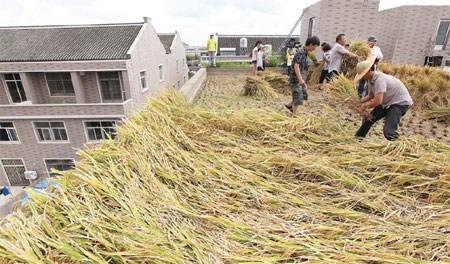
People hired by Tao Zhengrong harvest rice on the 133-square-meter rooftop of Tao's six-floor factory in Wenling, Zhejiang province, on Tuesday.
Facing a shortage of arable land, Tao Zhengrong decided to look to the skies for an answer. And he found one: on his roof.
The 49-year-old farmer used the flat roof of his factory in Zhejiang province to grow 115 kilograms of rice, roughly the same amount he could have expected from a piece of land the same size.
Now he is trying to get his neighbors to do the same.
"Some families have already followed suit," said Tao, who is head of Chengbei village. "What most people want to know is what the output is like from an unconventional field."
China is under tremendous pressure to protect its arable land, with 22 percent of the world's population relying on just 10 percent of the world's arable land.
In Chengbei, where the population stands at a few thousand, the demand for better land management is pressing.
The village's economy has taken off in recent years due to a flourishing car upholstery industry, with more than 100 businesses specializing in the production of car seat cushions. However, the development has been faced with the obstacle of land shortages, which has forced companies to operate out of small workshops and in residential houses, instead of a sophisticated industrial park.
Only a dozen companies have formed a fair-sized operation while the others remain weak and scattered, Tao said.
To resolve the problem, Tao came up with the bold idea of creating a joint development of agriculture and industry by erecting factories on farmland and planting crops on their rooftops.
He began to place rice seedlings on a 133-square-meter rooftop of his six-floor factory in May. The rooftop was covered with 25-cm-deep soil taken from the ground, and a water pipeline was used for irrigation.
"There's no special treatment of the rooftop prior to the cultivation," Tao said. Compared with the cultivation on traditional land, it requires less energy to attend the crop and used less pesticide, he added.
"There's no problem of water leaking into the building or any obstruction of the factory's operation. As a side effect, the cultivation helps cool the building down and saves the factory's air-conditioning expenses in the sweltering summer," he said.
Calling the attempt a success, Tao started preparing a second round of planting on Wednesday and shared his know-how with other interested families in the village.
"It is a completely new notion that I can grow crops on rooftops while using the land for industrial development. It might take one or two years to prove I am correct and gain approval."
However, rural affairs experts remain cool on the idea of promoting the exploitation of unconventional fields, due to concerns that it might prompt farmers to use their arable land for industrial or urban development.
Rural affairs authorities responsible for Chengbei could not be reached for comment on Thursday.

Copyright ©1999-2011 Chinanews.com. All rights reserved.
Reproduction in whole or in part without permission is prohibited.